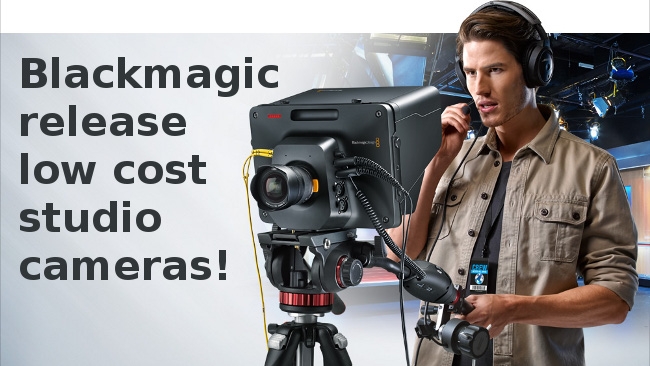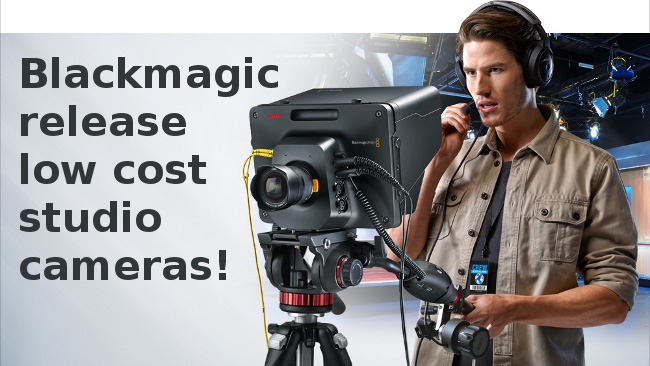
 Blackmagic Studio Camera
Blackmagic Studio Camera
Analysis: Blackmagic has designed what looks like an incredibly versatile and credible-looking studio camera.
I’m sure nobody was expecting a new camera from Blackmagic at NAB this year after so many amazing cameras from them in such a short time but it turns out we were wrong. Blackmagic are now set to unleash upon the world the Blackmagic Studio Camera. In fact they are releasing two Studio Cameras, a 1080p version and a UHD 4K version as well.

People have been eyeing up the original Blackmagic Cinema Camera for use in a studio context for some time, as that model had clean HD-SDI outputs and the price was definitely right, allowing people to buy three cameras and a switcher for far less than a single studio camera would have cost in the past! Unfortunately there are some downsides that can make this unworkable. The original Blackmagic cinema camera can only output 1080p and there are a lot of video switchers out there that will only accept 1080i including Blackmagics very own ATEM TV Studio switcher.
So, Blackmagic has come to the rescue with these two new cameras that are specifically aimed at studio use and have lots of new features to that end. Blackmagic seem keen to create an end to end workflow for both HD and UHD production. The new cameras support a wide range of frame rates. The HD model goes right up to 1080p60 but also supports a wide range of ordinary HD resolutions including 1080i50/60. The UHD model tops out at 3840 x 2160p30 however, so if you are doing high motion sports type footage or something similar then you might be just as well off with the HD model. On the other hand the UHD version does do 1080p50/60 as well so if you shoot a mix of things maybe that is the camera for you, just don’t expect to be able to shoot UHD at 50/60fps let alone 120fps!
Anyway, the bottom line is that with a wider range of frame rates and formats available, it should be possible to use the new studio cameras with a wider range of switchers than was possible with the original cinema camera.
The Blackmagic Studio cameras improve on the existing Blackmagic cameras by having huge 10“ HD Viewfinders. They also feature real XLR sockets both for audio and also a lovely 4pin XLR for power. Completely standard BNC sockets carry the SDI signals too so you shouldn’t need a ton of expensive adaptor cables or anything.

The cameras contain a huge battery which apparently can last up to four hours. I’ve never been sold on the internal batteries on the Blackmagic cameras in the past, and I’m even less sold on the idea when it's in a studio camera that has a four pin XLR socket anyway. If you are in the studio you will presumably have easy access to mains power. Okay if you are out and about you can save on a bit of wiring by already having power but you are still going to need cables to carry the SDI signals to the switcher (which will probably need mains power anyway!).
Speaking of power, the cameras can be powered from 12-24volts and even come with a mains supply, so it seems very versatile in this aspect.
There is no recording built into the cameras as standard and hopefully that will make it a bit easier for Blackmagic to have more comprehensive firmware than they have had in the past on their cameras, as they don’t have to support recording and filesystems and the like. However the cameras do seem to be very integrated with the Blackmagic ATEM production switchers which means additional firmware support there.
The cameras can be controlled over the SDI cables from the ATEM production switchers. It’s not clear which models support the cameras at present but I understand that Blackmagic have cleverly integrated the primary colour corrector from DaVinci Resolve into the ATEM production switcher! In addition to controlling the colour of the camera, you can also control camera settings and even remotely control the lens on the camera.

The cameras have Tally lights and talkback to the studio control centre (where the switcher is basically) using standard avaiation headsets. The Tally function supports the “Tally SDI” standard which is supported on their ATEM production switchers. Essentially both Tally and talkback can be carried back to the switcher alongside the video and audio on a single SDI cable.
I’ve talked a lot about SDI cable but there is also support to send the SDI signals over fibre optic cable too for really long runs! The HD Studio camera supports 3G-SDI and the 4K Studio camera uses 12G-SDI. 12G-SDI is supposed to support 3840 x 2160p60 so perhaps 60fps UHD could arrive in a future firmware update. I wouldn't like to hold my breath for that one though.
Lastly the lens mount is Micro 4/3. This does seem like the best option in a way because it allows a wide variety of lenses to be attached via adaptors including PL Mount and B4 mount. Of course it’s likely that any B4 mount will be dumb and so not easily controlled over LANC, however I get the impression that those who want B4 mount lenses on there will rig something up! Obviously you can use the LANC to control the electronics in active Micro 4/3 lenses. However I’m wondering if they shouldn’t consider a Canon EF mount version too, just because there are so many people with Canon EF mount lenses and they can also be easily controlled electronically. In any case Micro 4/3 is definitely still a good choice, it’s just not quite as straightforwardly the best choice as it is on their other cameras.
Here’s the thing. The price of the cameras is really surprisingly low. It’s $1,995 for the HD version and $2,995 for the “4K Studio Camera”.

I can’t actually imagine it being used by major broadcast television networks for the news but who knows? However it seems like it could be a great match for things like conferences and music concerts and the like. Seems like a very good camra for the new world of internet video in fact. Basically: production switching for the rest of us. In this sense it is quite radical as in theory you can create a whole television studio which is extremely portable. The small size of the cameras mean that you could easily carry three or four cameras in the space once taken up by a single old school studio camera and a 4K ATEM production switcher can be bought for as cheaply as $1,695 and fits in a 19“ rackspace!
It could be another quiet revolution in video production.
For more information check out Blackmagic's page on the camera here.
Tags: Production


Comments